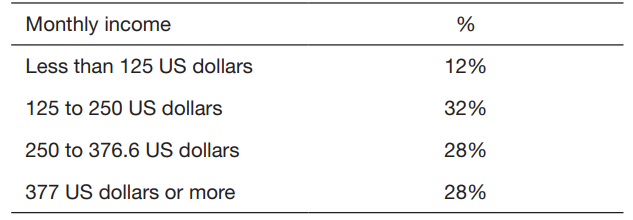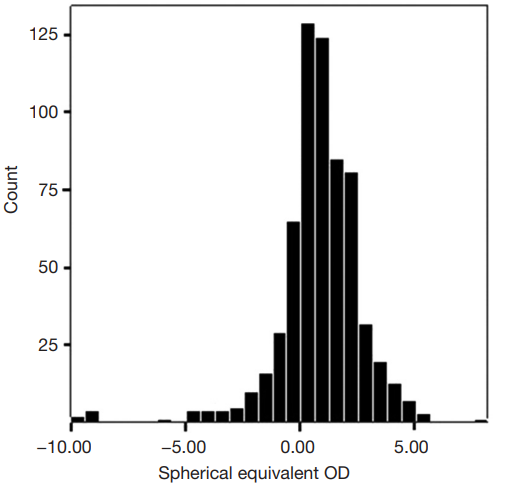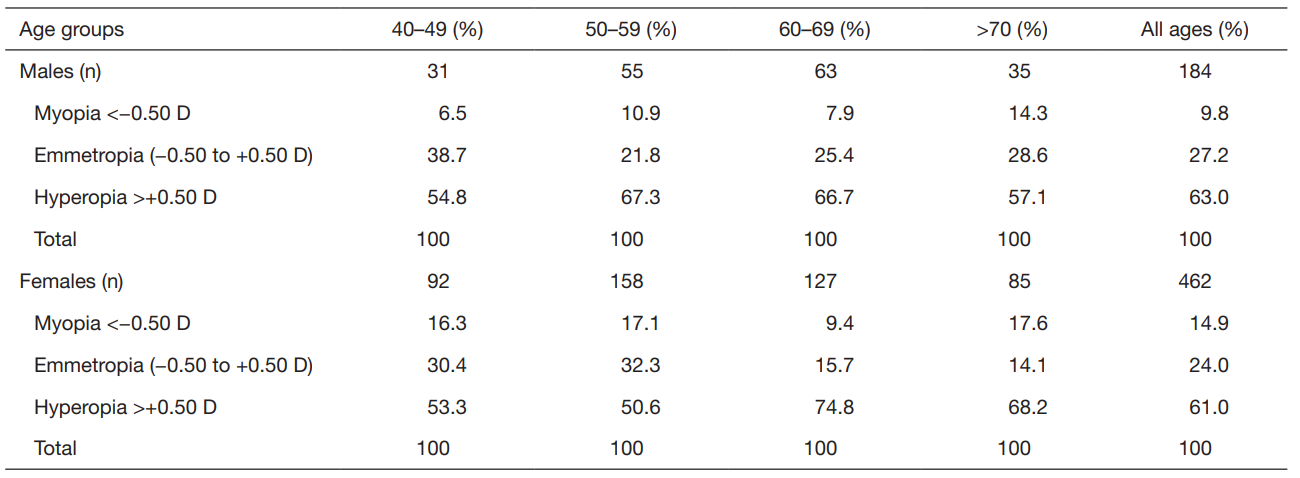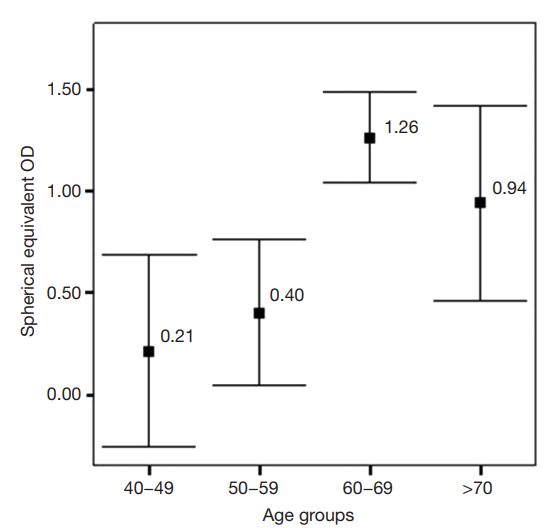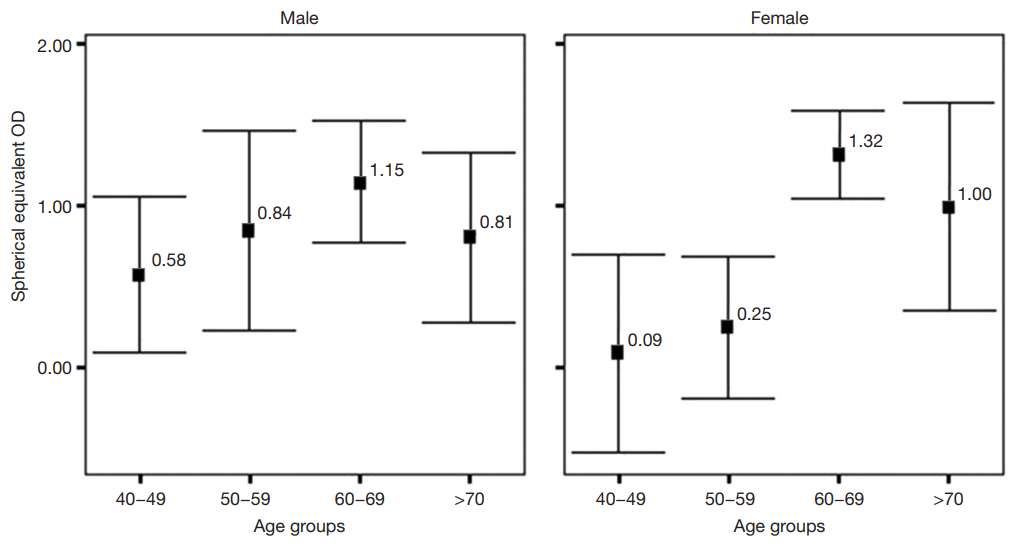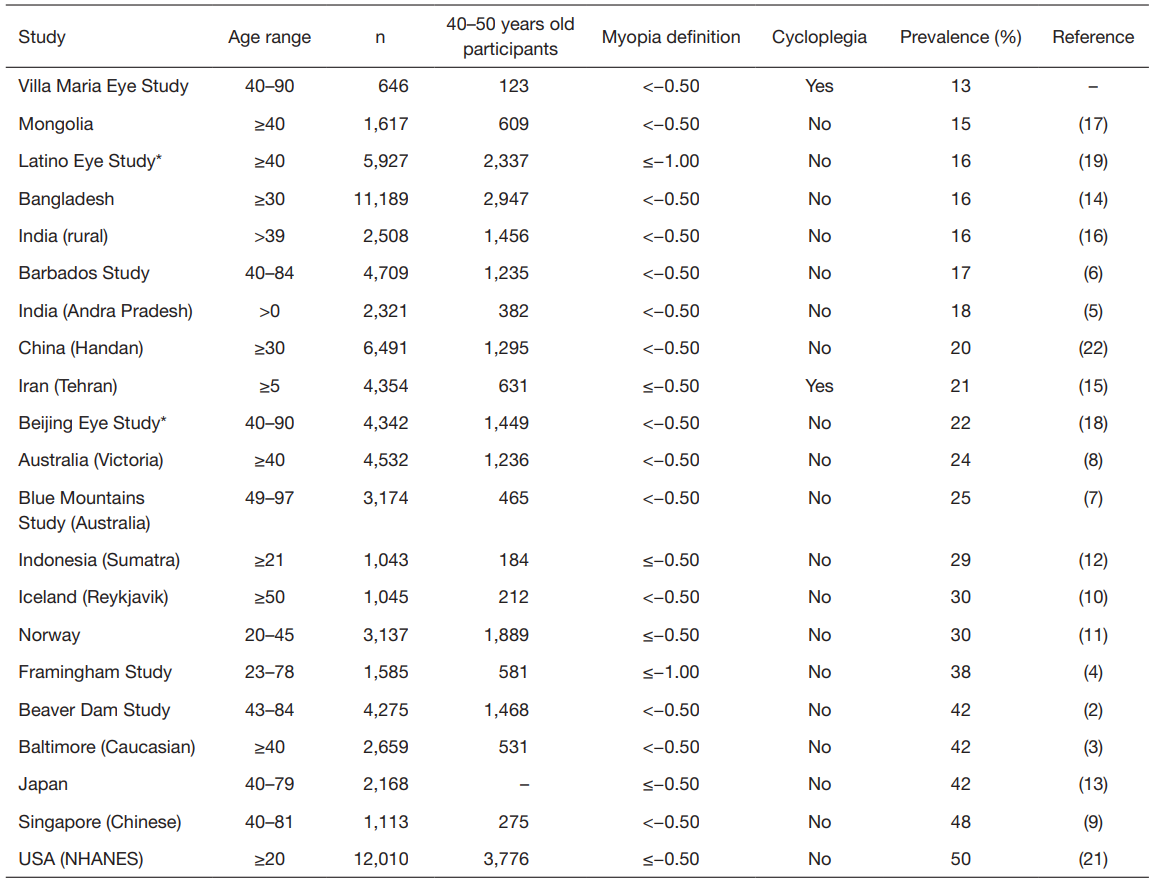1、World Health Organization. Part 3: Disease incidence, prevalence and disability. In: The global burden of disease: 2004 update. World Health Organization. Geneva: 2008:27-37.
2、Wang Q, Klein BE, Klein R, et al. Refractive status in the Beaver Dam Eye Study. Invest Ophthalmol Vis Sci 1994;35:4344-7.
3、Katz J, Tielsch JM, Sommer A. Prevalence and risk factors for refractive errors in an adult innerFramingham Offspring Eye Study Group1. city population. Invest Ophthalmol Vis Sci 1997;38:334-40.
4、Framingham Offspring Eye Study Group. Familial aggregation and prevalence of myopia in the Framingham Offspring Eye Study. Arch Ophthalmol 1996;114:326-32.
5、Dandona R, Dandona L, Srinivas M, et al. Populationbasedassessment of refractive error in India: the Andhra Pradesh eye disease study. Clin Experiment Ophthalmol 2002;30:84-93.
6、Wu SY, Nemesure B, Leske MC. Refractive errors in a black adult population: the Barbados Eye Study. Invest Ophthalmol Vis Sci 1999;40:2179-84.
7、Attebo K, Ivers RQ, Mitchell P. Refractive errors in an older population: the Blue Mountains Eye Study. Ophthalmology 1999;106:1066-72.
8、Wensor M, McCarty CA, Taylor HR. Prevalence and risk factors of myopia in Victoria, Australia. Arch Ophthalmol 1999;117:658-63.
9、Wong TY, Foster PJ, Hee J, et al. Prevalence and risk factors for refractive errors in adult Chinese in Singapore. Invest Ophthalmol Vis Sci 2000;41:2486-94.
10、Gudmundsdottir E, Jonasson F, Jonsson V, et al. "With the rule" astigmatism is not the rule in the elderly. Reykjavik Eye Study: a population based study of refraction and visual acuity in citizens of Reykjavik 50 years and older. Iceland-Japan Co-Working Study Groups. Acta Ophthalmol Scand 2000;78:642-6.
11、Midelfart A, Kinge B, Midelfart S, et al. Prevalence of refractive errors in young and middle-aged adults in Norway. Acta Ophthalmol Scand 2002;80:501-5.
12、Saw SM, Gazzard G, Koh D, et al. Prevalence rates of refractive errors in Sumatra, Indonesia. Invest Ophthalmol Vis Sci 2002;43:3174-80.
13、Shimizu N, Nomura H, Ando F, et al. Refractive errors and factors associated with myopia in an adult Japanese population. Jpn J Ophthalmol 2003;47:6-12.
14、Bourne RR, Dineen BP, Ali SM, et al. Prevalence of refractive error in Bangladeshi adults: results of the National Blindness and Low Vision Survey of Bangladesh. Ophthalmology 2004;111:1150-60.
15、Hashemi H, Fotouhi A, Mohammad K. The ageand gender-specific prevalences of refractive errors inTehran: the Tehran Eye Study. Ophthalmic Epidemiol 2004;11:213-25.
16、Raju P, Ramesh SV, Arvind H, et al. Prevalence of refractive errors in a rural South Indian population. Invest Ophthalmol Vis Sci 2004;45:4268-72.
17、Wickremasinghe S, Foster PJ, Uranchimeg D, et al. Ocular biometry and refraction in Mongolian adults. Invest Ophthalmol Vis Sci 2004;45:776-83.
18、Xu L, Li J, Cui T, et al. Refractive error in urban and rural adult Chinese in Beijing. Ophthalmology 2005;112:1676-83.
19、Tarczy-Hornoch K, Ying-Lai M, Varma R, et al. Myopic refractive error in adult Latinos: the Los Angeles Latino Eye Study. Invest Ophthalmol Vis Sci 2006;47:1845-52.
20、Saw SM, Chan YH, Wong WL, et al. Prevalence and risk factors for refractive errors in the Singapore Malay Eye Survey. Ophthalmology 2008;115:1713-9.
21、Vitale S, Ellwein L, Cotch MF, et al. Prevalence of refractive error in the United States, 1999-2004. Arch Ophthalmol 2008;126:1111-9.
22、Liang YB, Wong TY, Sun LP, et al. Refractive errors in a rural Chinese adult population the Handan eye study. Ophthalmology 2009;116:2119-27.
23、Barrenechea R, de la Fuente I, Plaza RG, et al. National survey of blindness and avoidable visual impairment in Argentina, 2013. Rev Panam Salud Publica 2015;37:7-12.
24、Bennett S, Woods T, Liyanage WM, et al. A simplified general method for cluster-sample surveys of health in developing countries. World Health Stat Q 1991;44:98-106.
25、Bartlett JE II, Kotrlik JW, Higgins CC. Organizational research: determining appropriate sample size in survey research. Information Technology, Learning, and Performance Journal 2001;19:43-50.
26、Chylack LT Jr, Leske MC, McCarthy D, et al. Lens opacities classification system II (LOCS II) . Arch Ophthalmol 1989;107:991-7.
27、Fotouhi A, Morgan IG, Iribarren R, et al. Validity of noncycloplegic refraction in the assessment of refractive errors: the Tehran Eye Study. Acta Ophthalmol 2012;90:380-6.
28、Hashemi H, Iribarren R, Morgan IG, et al. Increased hyperopia with ageing based on cycloplegic refractions in adults: the Tehran Eye Study. Br J Ophthalmol 2010;94:20-3.
29、Hashemi H, Khabazkhoob M, Iribarren R, et al. Five Year Change in Refraction and its Ocular Components in the 40-64 Year Old Population of the Shahroud Eye Cohort
Study. Clin Experiment Ophthalmol 2016. [Epub ahead of print].
30、Morgan IG, Ohno-Matsui K, Saw SM. Myopia. Lancet 2012;379:1739-48.
31、Morgan%20I%2C%20Rose%20K.%20How%20genetic%20is%20school%20myopia%3F%20Prog%20Retin%20Eye%20Res%202005%3B24%3A1-38.
32、Pan CW, Chen Q, Sheng X, et al. Ethnic variations in myopia and ocular biometry among adults in a rural community in China: the Yunnan minority eye studies. Invest Ophthalmol Vis Sci 2015;56:3235-41.
33、Morgan IG, Rose K. Yunnan Minority Eye Study Suggests That Ethnic Differences in Myopia Are Due to Different Environmental Exposures. Invest Ophthalmol Vis Sci 2015;56:4430.
34、Corach D, Lao O, Bobillo C, et al. Inferring continental ancestry of argentineans from Autosomal, Y-chromosomal and mitochondrial DNA. Ann Hum Genet 2010;74:65-76.
35、Williams KM, Verhoeven VJ, Cumberland P, et al. Prevalence of refractive error in Europe: the European Eye Epidemiology (E(3)) Consortium. Eur J Epidemiol 2015;30:305-15.
36、Cortinez MF, Chiappe JP, Iribarren R. Prevalence of refractive errors in a population of office-workers in Buenos Aires, Argentina. Ophthalmic Epidemiol 2008;15:10-6.
37、Iribarren R, Morgan IG, Hashemi H, et al. Lens power in a population-based cross-sectional sample of adults aged 40 to 64 years in the Shahroud Eye Study. Invest Ophthalmol Vis Sci 2014;55:1031-9.
38、Iribarren R, Iribarren G. Prevalence of myopic shifts among patients seeking cataract surgery. Medicina (B Aires) 2013;73:207-12.
39、Díez Ajenjo MA, García Domene MC, Peris Martínez C. Refractive changes in nuclear, cortical and posterior subcapsular cataracts. effect of the type and grade. J Optom 2015;8:86-92.
40、Hashemi H, Khabazkhoob M, Yekta A, et al. High prevalence of astigmatism in the 40- to 64-yearoldpopulation of Shahroud, Iran. Clin Experiment Ophthalmol 2012;40:247-54.
41、Ziaei H, Katibeh M, Solaimanizad R, et al. Prevalence of refractive errors; the yazd eye study. J Ophthalmic Vis Res 2013;8:227-36.
42、Yekta AA, Fotouhi A, Khabazkhoob M, et al. The prevalence of refractive errors and its determinants in the elderly population of Mashhad, Iran. Ophthalmic Epidemiol 2009;16:198-203.
43、Gudmundsdottir E, Jonasson F, Jonsson V, et al. "With the rule" astigmatism is not the rule in the elderly. Reykjavik Eye Study: a population based study of refraction and visual acuity in citizens of Reykjavik 50 years and older. Iceland-Japan Co-Working Study Groups. Acta Ophthalmol Scand 2000;78:642-6.
44、Ueno Y, Hiraoka T, Beheregaray S, et al. Age-related changes in anterior, posterior, and total corneal astigmatism. J Refract Surg 2014;30:192-7.
45、Ho JD, Liou SW, Tsai RJ, et al. Effects of aging on anterior and posterior corneal astigmatism. Cornea 2010;29:632-7.
46、Hyman L, Patel I. Epidemiology of refractive errors and presbyopia. In: Johnson G, Minassian DC, Weale RA, et al., editors. The epidemiology of Eye Disease. Third edition. London, Imperial College Press, 2012:197-240.

